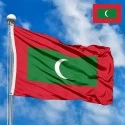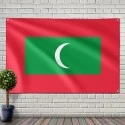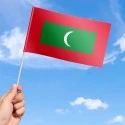The national flag of the Maldives is a striking and meaningful symbol, embodying the island nation's deep-rooted cultural values, its unique geography, and its unwavering commitment to peace and prosperity. Floating amidst the azure waters of the Indian Ocean, the Maldivian flag tells a story of an ancient maritime history, a vibrant Islamic heritage, and the tranquil beauty that defines this archipelago paradise.
Design and Dimensions
The flag of Maldives features a red field that forms its outer boundary, symbolizing the nation's courage and the sacrifices made for its independence. Inside this red border, there's a large green rectangle, which represents the lush palm trees that are abundant across the islands, symbolizing life and prosperity. Centered within this green rectangle is a prominent white crescent moon, depicted with its open side facing the hoist (left side) of the flag. The standard proportions for the Maldivian flag are 2:3 (height to width), giving it a classic rectangular shape.
Symbolism of the Colors and Elements
Each color and element on the Maldivian flag carries profound symbolic meaning:
-
Red Outer Field: The dominant red color of the flag symbolizes the courage and determination of the Maldivian people, and the sacrifices made by national heroes for the country's independence and sovereignty. It stands as a reminder of their willingness to shed blood for their nation.
-
Green Inner Rectangle: The green rectangle represents peace and prosperity. It specifically symbolizes the lush palm trees that are an iconic feature of the Maldivian islands, vital for the livelihoods of the islanders. The green also signifies hope, progress, and the nation's agricultural wealth, especially from coconut palms.
-
White Crescent Moon: The white crescent moon is a powerful emblem of Islam, the state religion of the Maldives. It signifies the purity of faith, peace, and the prosperity brought by adherence to Islamic values. Its white color emphasizes purity, honesty, and peace, reflecting the moral fabric of Maldivian society. The orientation of the crescent (open side facing the hoist) is a traditional Islamic representation.
History of Creation and Adoption
The history of the Maldivian flag reflects the nation's evolution through various periods of governance and independence. Early flags of the Maldives were simpler, often plain red banners, occasionally adorned with a crescent. During the early 20th century, particularly under the reign of Sultan Muhammad Shamsuddeen III (early 1900s), a flag with a green rectangle and white crescent was introduced, though the exact design and proportions evolved over time.
Before 1965, the flag also featured a white stripe on the hoist side, known as the "Dhivelhi Gos," which contained black diagonal stripes. This element was a unique design feature but was removed upon achieving full independence.
The current design of the flag was officially adopted on July 26, 1965, the day the Maldives gained full independence from the British protectorate. This marked a significant moment in the nation's history, as the new flag symbolized its newfound sovereignty and its identity as an independent Islamic nation. The design was the result of deliberations aimed at creating a modern national symbol that retained traditional elements while looking towards the future.
Significance for the Inhabitants
For the people of the Maldives, the national flag is an object of immense pride and national identity. It represents their unique island nation, their strong Islamic faith, and their centuries-long struggle for self-determination. The flag is seen not just as a national emblem but as a living symbol of their history, their peaceful way of life, and their aspirations for continued prosperity.
It serves as a constant reminder of their rich cultural heritage, their resilience in the face of environmental challenges (like rising sea levels), and their unity as a nation. Displayed prominently on public buildings, fishing boats, and during national celebrations, the flag evokes a deep sense of belonging and inspires patriotism. It embodies the collective dreams of a tranquil paradise, guided by faith and a commitment to preserving their unique island existence.
Interesting Facts
-
Island Nation's Identity: The green rectangle specifically pays homage to the palm trees, which are central to the Maldivian way of life and economy, reflecting the nation's deep connection to its environment.
-
Symbol of Independence: The current flag was raised for the first time on July 26, 1965, the very day the Maldives became a fully independent republic, making it a direct symbol of their sovereignty.
-
Islamic Heritage: The white crescent moon is a universal symbol of Islam, reinforcing the country's official religion and the strong role of faith in society.
-
Evolution of Design: Older versions of the Maldivian flag included an additional white stripe with diagonal black lines on the hoist side, which was removed with the current 1965 design to simplify and modernize the flag.
-
Maritime Nation: While not directly symbolized in the current flag's elements, the red background's historical association with bravery also subtly echoes the courage required for life in a nation surrounded by the vast and often challenging ocean.
In the demonstration images, full-size flags are shown with proportions of 2:3, and hand-held flags with proportions of 1:2.






 Waving flag
Waving flag
 Sizes:
Sizes:
 Round flag
Round flag
 Sizes:
Sizes:
 Rectangular flag 2:3
Rectangular flag 2:3
 Sizes:
Sizes: